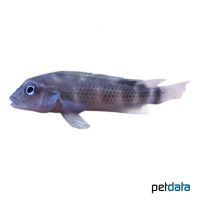Lionhead Cichlid (Steatocranus casuarius)
| Lionhead Cichlid Steatocranus casuarius | |
|---|---|
| Name | Lionhead Cichlid |
| Name Lat. | Steatocranus casuarius |
| Family | Cichlids |
| Family lat. | Cichlidae |
| Order | Cichlids |
| Order lat. | Cichliformes |
| Origin | Africa |
| Habitat | Rivers, tributaries |
| Diet | Carnivore |
| pH | 6.0-7.5 |
| Behavior | Peaceful |
| Keeping | Pair |
| Care Level | Moderate |
| Reproduction | Cave spawner |
| Breeding | Simple |
| Life Span | 5-8 years |
| Protection | No |
| Metric Units | |
| Size | 8-12 cm |
| Temperature | 24-28 °C |
| Hardness | 2-15 °dH |
| Aquarium | ~ 150 l |
| US Units | |
| Size | 3"-4.7" |
| Temperature | 75-82 °F |
| Hardness | 36-267 ppm |
| Aquarium | ~ 40 gal |
Distribution and habitat
Helm's cichlids are native to the Malebo Pool (formerly Stanley Pool) and fast-flowing portions of the lower Congo River with its tributaries. They stay in the calm water zones of the rocky rapids.
Maintenance
The aquarium should have many hiding places, such as stones, roots and caves (e.g. halved coconuts, tubes) and offer free bottom areas. A graveable substrate of sand or fine gravel, a medium current and oxygen-rich water is ideal.
No ammonia, ammonium or nitrite should be detectable, and the nitrate value should not exceed 100 mg/l. To ensure the water quality and oxygen content, a filter and heater adapted to the aquarium size is required, as well as lighting for the species-appropriate day-night rhythm of the animals.
Diet
The food supply consists of live food, such as daphnia, cyclops, artemia, mysis and black mosquito larvae, which is also accepted without problems in frozen form or a commercially available frozen special food mix. Protein-rich dry food (flakes, granules, pellets) for cichlids is also accepted without problems, but should not be the main component of the diet.
It is recommended to feed small portions several times a day. Only as much should be fed as is eaten within a few minutes. A regular and varied diet promotes health and increases resistance.
Behaviour and compatibility
These quiet and sociable fish form solid pairs and defend their territory very vigorously during the breeding season. Keeping several pairs is only recommended in a much larger and richly structured tank. They can be socialized well with other peaceful fish. Keeping them together with other cichlids should be avoided.
Basically, only compatible fish species with similar demands on water condition and water temperature should be socialized.
Sex dimorphism
The male is larger and gets a powerful forehead hump (fat deposit) when old, which is much smaller in the females.
Reproduction and breeding
They are cave breeders and attach the spawn, 20-150 eggs, usually to the cave ceiling or walls. The female performs brood care, while the male defends the territory (parental family). The fry hatch after 5-7 days and swim free after 11-14 days. Both parents continue to guard the fry for some time and lead them to feeding sites in the aquarium before brood care ends
Fry must be fed several times a day with special rearing food (Artemia nauplii). In community tanks breeding is hardly possible, because the fry are easy prey.
Important
They are bottom-dwelling, have a receded swim bladder, and move along the bottom in a jerky manner (belly-sliding). They can swim only with great effort, without immediately sinking to the bottom. They are thus adapted to life in current-rich waters
The well-being of the fish should be checked regularly. The temperature should be checked daily, the pH value, hardness and nitrate value at least every 14 days. Regular partial water changes are recommended, even if the pollutant load has not yet reached the upper limit. Sudden changes in water quality should be avoided. Newly introduced fish must be accustomed slowly to the water in the aquarium.
Further literature can be found in your pet store.
References
Text: Werner Winter; Image: petdata
Source: BMEL (1998): Tierschutzgutachten - Haltung von Zierfischen (Süßwasser); RIEHL & BAENSCH (2006): Aquarien Atlas Bd. 1, Mergus Verlag; ENGELMANN (2005): Zootierhaltung - Tiere in menschlicher Obhut: Fische, Verlag Harri Deutsch
- Gemäß § 21 Abs. 5 Tierschutzgesetz idgF
